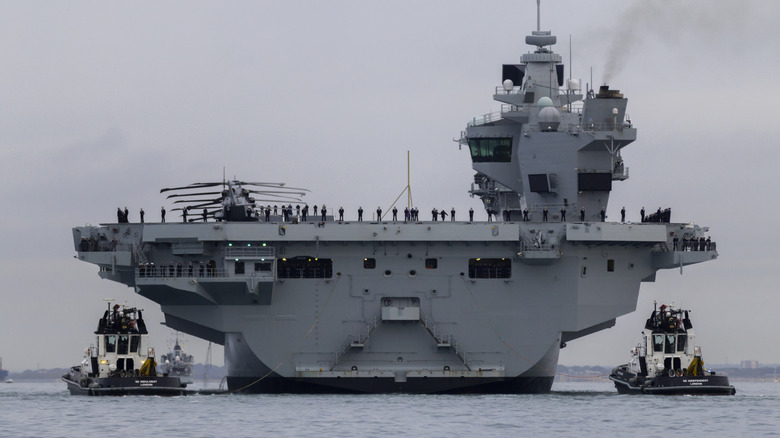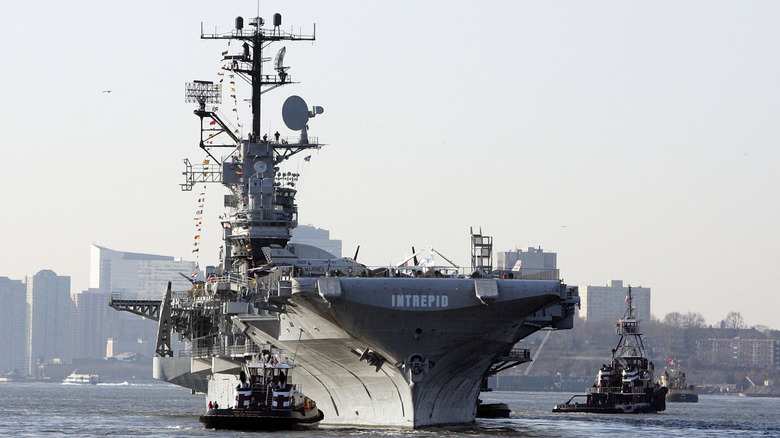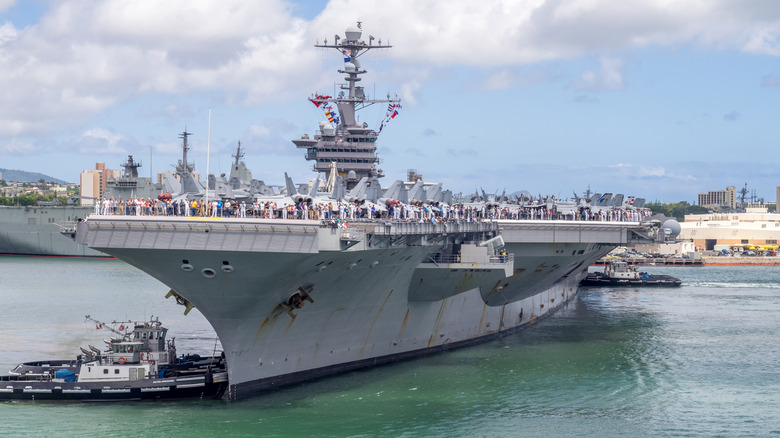Can A Tugboat Pull An Aircraft Carrier?
On the face of it, comparing an aircraft carrier with a tugboat is like comparing a family saloon car with a locomotive. It should be a no-contest. For instance, the U.S. Navy Nimitz-class is among the biggest aircraft carriers, at about 1,040 feet in length, with a displacement of approximately 100,000 tons, and a crew of around 6,000. Tugboats, on the other hand, typically measure between 65 and 105 feet in length, and an average U.S. tugboat weighs in at 150 to 200 tons. However, despite their diminutive comparative size, tugboats punch well above their weight with a huge amount of power. Depending on size, tugboat engines kick out about 680 to 3400 hp.
In terms of pulling power, this gives typical tugboats a power-to-weight ratio (PWR) of about 9.5, significantly more PWR than a typical container ship. It's this PWR that enables tugboats to move vessels more than 1,000 times their weight. Bearing these performance stats in mind, it's possible to say that — yes, an average tug can indeed pull an aircraft carrier. However, a single tug pulling an aircraft carrier is not a sight you're likely to see. Tug boats don't just pull aircraft carriers, they maneuver them. This requires teams of tugs working to pull and push the vast ships into place. Let's take a closer look at tugboats and how they make moving massive aircraft carriers look easy.
How tugboats generate their extraordinary pulling power
Power is of obvious importance to a tugboat, but just as crucial is how that power translates into pulling capacity. This is a metric known as bollard pull and is a measurement of the pulling capability of a vessel. The clue is in the name, as bollard pull is measured by attaching a towline to a bollard and measuring the tension that a stationary vessel can put on the line. An average tug uses all the power at its disposal, its propellers, and low draft for an average of about 110 tons of pulling (and pushing) power. Knowing this rating is important to prevent tugs from being used that aren't powerful enough to move the vessel in question.
Tugs deliver this incredible bollard pull rating through powerful engines and advanced propulsion systems. How this happens largely depends on the type of tug. There are a general classifications to consider. The first is conventional tugs, if you have a picture of a tug in your head, then this is probably it. These workhorses use fixed propellers with rudders or moveable nozzles to maneuver. The next classification is tractor tugs, they use powerful winches and engines located in the bow to maximize maneuverability. Finally, the more advanced Azimuthal Stern Drive tugs use propellers that rotate 360 degrees horizontally to deliver more power than the other types. It is these characteristics that allow tugs to maneuver massive aircraft carriers loaded with fearsome fighter jets, despite the huge disparity in size and weight.
How tugboats maneuver massive aircraft carriers
Maneuvering an aircraft carrier — one of the biggest vessels in the world — within the confined spaces of a harbor is no small feat and one that requires the specialist capabilities of tugs. For instance, moving an aircraft carrier into a dry dock is a highly choreographed operation. It involves a diverse team of the carrier's crew, onshore staff, the crew of several tugboats, tug masters, and harbor pilots — to name a few. When the operation is underway, the tugs pull and push the carrier as required until it is precisely positioned above the keel blocks in the dry dock. This is an exacting and difficult enough job in the best of times, but throw some inclement weather and strong tides into the mix, and the skill of all those personnel along with the capabilities of the tugs are pushed to the limits.
The number of tugboats involved in any operation can vary depending on factors such as the carrier's size, bollard pull of the tugs, harbor layout, and weather and tidal conditions. However, as noted earlier, it is highly unlikely that it would ever be left to a single tug. So, although in theory, a single tug could pull an aircraft carrier, the reality is that teams of these incredible machines work in unison to push, pull, and otherwise gently persuade these giant ships to maneuver around harbors and docks.


